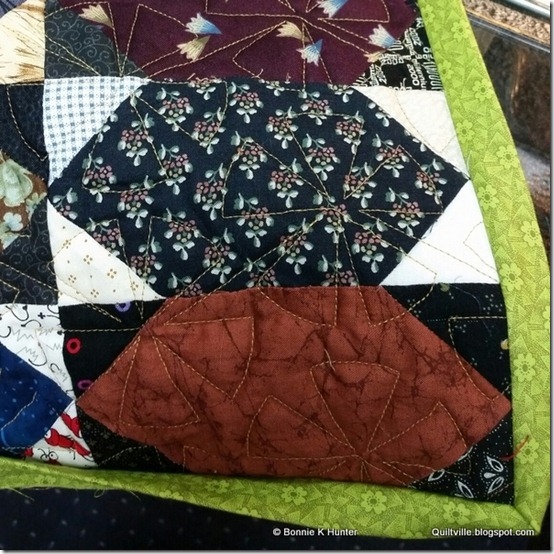
I’ve had quite a few messages and emails asking if I would share how I bind my quilts for a 1/4” finished binding.
I am happy to oblige! I just needed to be actually BINDING a quilt to be able to take photos and do it.
Quite a few of my quilts have pieced borders, and even quilts with no borders, such as the Lozenges Quilt I just finished here need a binding that will not chop off the points of the units at the edge of the quilt.
A wider binding is just going to be too wide.
An upside of narrower binding? It gives you a very full binding with no saggy baggy empty spots.
Even better…on a quilt that takes 10 strips of fabric to go around the circumference of the quilt – by using 2” strips rather than 2.5” strips – I use 5” less of fabric –that translates into $$$!
On average, a quilt for me generally takes 8 to 9 strips, and I can get that easily out of a 1/2 yard of fabric.
So let’s start at the beginning with 2” strips. Figure out the circumference of your quilt in inches and divide that by 40. If your quilt is 70” X 90” you will have 320” all the way around your quilt. Divide 320” by 40 ((the useable width of fabric minus selvages)) and you will have 8. Now there are seams and corners involved, so I always add one extra strip just in case. So I would cut 9 2” strips.
Getting ready to chain sew these!
Position the ends of two strips with right sides together and perpendicular. Off set them a bit so you can see where you need to shoot! Start stitching in the V at the top, and continues on the diagonal, exiting the seam at the V at the bottom. DO NOT REMOVE FROM MACHINE!
Take the top strip, find the other end, and fold it up, placing the bottom end right sides up on the table top so you can match a third strip to it:
Adding the next strip, overlapped as the first pair.
Continue adding strips all in one chain with ends sewn on the diagonal!
Snip the excess 1/4” beyond each seam as you cut the chain apart.
Press seams open.
I then press the whole strip in half matching raw edges with wrong sides together. This keeps the binding from shifting and twisting while I sew it to the quilt.
Before attaching to quilt…Fold over one end and run a pin along the edge…
This places the pin 2” down from the top edge of the binding. Just stitch in and out with it to keep it there while you bind. You can also mark this 2” line with a ruler and pen if you want, but this works great for me.
Setting up to sew! Use an ironing board to your left to help support the weight of the quilt.
Start about half way down one side, leaving an 8” tail of binding behind you.
About walking feet: They are IMPORTANT! I sew on vintage machines. A straight stitch only machine requires a straight stitch walking foot, not a zig zag one, because of the position of the feet on the bottom of the walking foot. They need to work along with the feed dogs on the machine, so be sure you have the right one for the job. I leave this machine set up all the time ready for binding.
Use a 1/4” seam allowance!
The foot is wider than 1/4” so I have marked my seam using a piece of old hotel room key and double stick Scotch re-stickable mounting strip. For more info, click the Tips & Techniques tab at the top of the blog and scroll down to B for BEST SEAM GUIDE EVER.
Place the guide just in front of the foot. Do NOT cover up feed dogs on any machine!
Place the guide just in front of the foot. Do NOT cover up feed dogs on any machine!
Stop stitching 1/4” before the edge of the quilt! Remove quilt from machine.
Double check! Did I leave 1/4” ? Yes!
Take the binding and fold it up and away from the quilt body leaving a diagonal fold as shown.
The raw edge of the binding should be even with the side of the quilt.
Fold it back down again, with the mitered fold underneath and another fold at the top edge of the quilt corner. Your corner should be nice and square here.
Checking that corner!
Start stitching at the top fold of the binding at the corner, and when you have gone down part way, double check by opening up that binding fold. You should have a nice miter, and room to roll that binding over the edge to the back of the quilt.
1/4" finished binding means I don’t lose my points!
Remember that pin??
Continue sewing the binding around the quilt, mitering corners as you go. Stop the seam, leaving about 8 to 10” unsewn when you get back around to where you started. You need room to maneuver at this point. Overlap the ends of your binding, and trim just above the pin. We want a snug finish, so trimming 1/8” above the pin allows some stretch in the binding so I don’t get a pucker when I sew the final finishing seam.
Ready for last seam!
Pull the loose binding ends away from the quilt, and overlap the ends as shown with right sides together. Start your stitching in the V at the top, sewing across the diagonal, and exiting at the bottom corner of the strip.
It’s kind of bulky and fussy, but you can do it!
Trim the excess, and finger press this seam open.
Here we go for an easy finish!
Because I cut the end of the strip 1/8” short, I get a nice tight finish with no pucker or pleat when I reach where I started. I’m a happy binder!
I’ll have a stack of 3 quilts ready to hand bind during my 3 weeks off in July. There will be lots of Quilt Villa cabin time for movie watching and binding stitching in the evenings.
Don’t forget there is QUILT-CAM this AFTERNOON at 2pm Eastern! That’s 7 pm UK time and 8pm for most of Europe!
See you then!



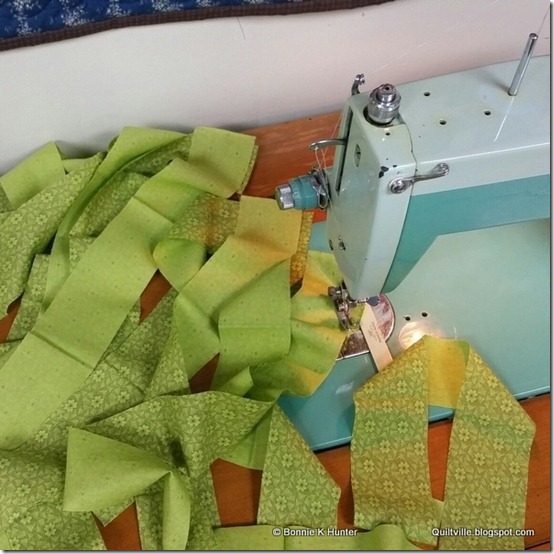


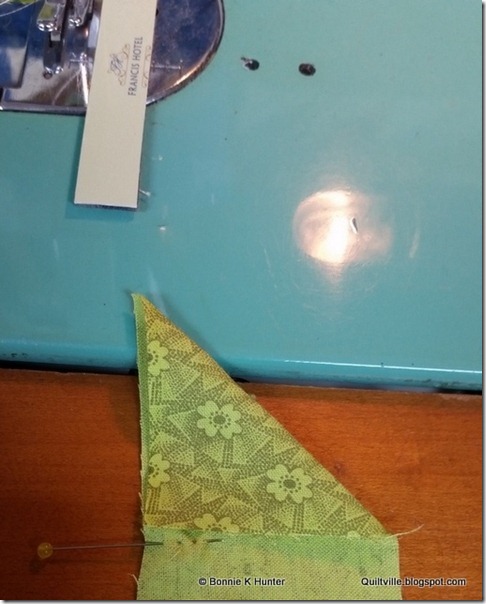

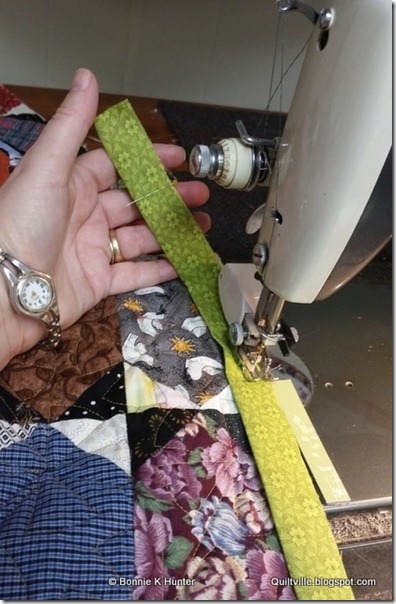




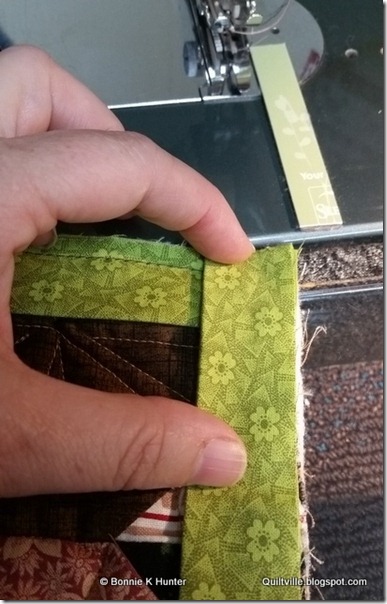





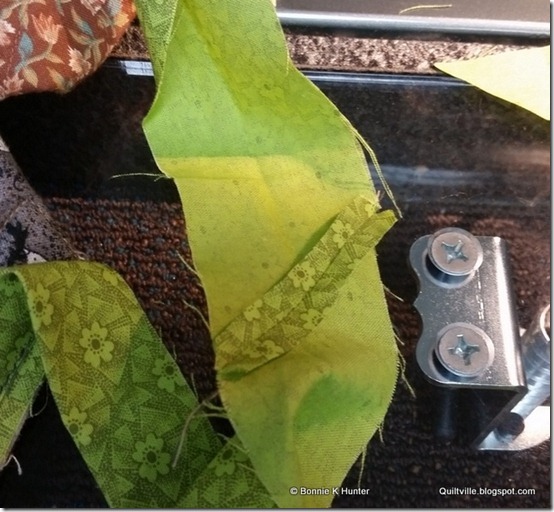


Thanks Bonnie! Very helpful!
ReplyDeleteThanks Bonnie! This was helpful :)
ReplyDeleteNadia in San Diego
That is exactly how I bind except I am still using 2 1/2" strips....I think I will try your 2" binding technique soon (I have a plastic container full of waiting binding packets in all colorways that I need to use first! I LOVE scrappy binding - thanks to you - so whenever I have severak 2 1/2" strips in the same colorway, I make a binding roll! :))
ReplyDeleteThanks again for all that you do!
Hugs, sao in Midlothian, VA
When you are joining the last strips of binding together after sewing on the quilt, make a pleat in your quilt and hold it with a safety pin. It won't pull on your binding when you are sewing it together. Jill O in Montana
ReplyDeleteThanks Bonnie. I do my last connection a little different, but also cut it a little "short" so there are no puckers. One thing you mentioned recently and was not in this tutorial was that you will cut your binding while sewing onto quilt if the seam is going to hit in the corner thus changing where the seam falls. I had never heard that before and thought it was a great idea...also another reason to have an extra length of fabric for binding. Rosalie rjoehnk@txwinet.com
ReplyDeleteThanks, i have used this method before, but have difficulty with matching the two tails at the end. Seems I either twist them, have trouble arranging the proper right sides together. But love the tutorial and will refer back to it. Love your style! Thanks your all your support and help Bonnie.
ReplyDeleteMy are still on the wall, and you have encouraged me to get her done!
I bind the same way. I use a 2.25" wide binding and a 1/4" seam. If I use a 2.5" binding I use a 3/8" seam.
ReplyDeleteMost of the time I sew the binding on before I trim the excess from the quilt. And when I trim I l cut about 1/8 - 1/4"
beyond the quilt top edge. This gives me a really full binding.
If you press the binding away from the quilt after you have sewn it on you will not need to use clip or pins when you sew the binding to the back. It folds over on its own.Try it and you may like it.
ReplyDeleteI've been meaning to post a note to the quiltville Yahoo group about a binding trick I figured out. I use the Easy Angle to cut my strip ends to join them. I was getting very frustrated with lining up the two square ends and sewing on the diagonal. It doesn't line up in a nice way for me. After I cut the strip ends with the Easy Angle, I then chain piece the perfect mitered joins, and bind my quilts just like Bonnie. I'll try to post some pictures and instructions at the group page today.
ReplyDeleteTracy
I have never used a walking foot to put on binding but from now on this is the method I will use!! Thank you for explaining this and for all that you do for us!!!! You are awesome!!!
ReplyDeleteBonnie, why do you iron your seams open? kjhallquist@mchsi.com.
ReplyDeleteI thought I had come up with an easy way to make that final join, but yours is even easier! I'm definitely going to try it with my next binding.
ReplyDeleteExcellent tutorial... thanks Bonnie!
ReplyDelete"See" you in an hour!
I use 2 1/4" binding and don't lose points. Thanks for the Tip on folding down the corner and using the Pin to mark for that final connection. I hadn't seen that trick before. QuiltCAm at 11 am PNW time. Yahoo!
ReplyDeleteThanks Bonnie, always interesting to see how other people do binding. I have a slightly different method for measuring where to join the ends, but your tips will assist me to not leave such a big tail next time. My general grip about binding is my walking foot is so wide, I find it hard to stay "on" the 1/4" - but I am going to trial setting something up to accommodate the bulk weight of the quilt, so it doesn't drag so much. Thanks again for the free tutorial.
ReplyDeleteJust like I do it. I am up to the binding stage on my lozenge quilt too. Until we start our new Leaders & Enders Challenge I am working on the Idaho Square Dance blocks as I have lots of scraps under 2 inch that i need to use.
ReplyDeleteHey Bonnie -
ReplyDeleteThat was a great tutorial on binding. But I do have one question? Do you cut your strips on the bias of the fabric or straight grain?
Thank for the tutorial
Brenda
Thank you, great tutorial and pictures help me a lot.
ReplyDeleteI always sew the binding to the front and turn to the back. This way the binding is always 1/4" on the front and wider on the back. I've been told many times my way is wrong. ?
ReplyDeleteCindy, I believe you are doing it correctly.
ReplyDeleteSomething I've learned: when approaching a corner to make the turn, I get to about 3/8" of the edge instead of to the 1/4" mark. I back stitch a couple of stitches to lock it, then turn the binding just exactly the way Bonnie shows. It keeps the stitching out of the miter, and holds very well. I've used 2" binding strips for years, and you can do it with either straight of grain or bias pieces. --Julie
I have been using 2" binding strips because it's easier to keep the binding on the back even when I tack it down. It reaches just over the line of stitches from the front. Also, the pockets at the corner are small enough so that they don't absolutely have to be stitched up, but please don't tell the Quilt Police. - Lu Anne
ReplyDelete